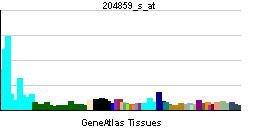Entrez 317 | Ensembl ENSG00000120868 | |
 | ||
Aliases APAF1, APAF-1, CED4, apoptotic peptidase activating factor 1 External IDs MGI: 1306796 HomoloGene: 7626 GeneCards: APAF1 | ||
Apoptotic protease activating factor 1, also known as APAF1, is a human homolog of C. elegans CED-4 gene.
Contents
Function
This gene encodes a cytoplasmic protein that forms one of the central hubs in the apoptosis regulatory network. This protein contains (from the N terminal) a caspase recruitment domain (CARD), an ATPase domain (NB-ARC), few short helical domains and then several copies of the WD40 repeat domain. Upon binding cytochrome c and dATP, this protein forms an oligomeric apoptosome. The apoptosome binds and cleaves Procaspase 9 protein, releasing its mature, activated form. The precise mechanism for this reaction is still debated though work published by Guy Salvesen suggests that the apoptosome may induce caspase 9 dimerization and subsequent autocatalysis. Activated caspase 9 stimulates the subsequent caspase cascade that commits the cell to apoptosis.
Alternative splicing results in several transcript variants encoding different isoforms.
Structure
APAF1 contains a Greek key motif composed of six helices, a Rossman fold nucleotide binding domains, a short helical motif and a winged-helix domain. It contains a CARD domain with a
Interactions
APAF1 has been shown to interact with:
